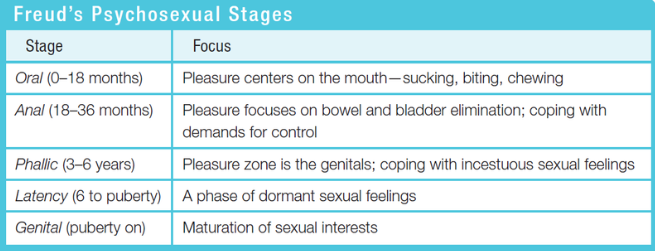AP Psych: Personality
Personality: Set of thoughts, feelings, traits, and behaviors that are characteristics of a person and consistent over time.
Exploring the Self:
The Self: the center of the personality, organized, feelings, and actions.
Self-Esteem: feelings of self-worth. High self-esteem is not easily understood.
Collectivism: identity is determined by being a member of a group, and its goals.
Individualism: identity is determined by one’s own personality traits and goals.
Self-Serving Bias: people tend to see themselves as better than average. Accepts responsibility for good deeds but not bad deeds—success not failure.
Assessment Techniques
Projective Tests
Description: reports a neutral stimulus and assumes that test-takers will project their subconscious thoughts or feelings onto the stimulus. (Exception: Rorschach Inkblot Test)
Use: psychoanalysts, and talk therapy. Identify topics of conversation in therapy.
Self-Reported Tests
Description: multiple-choice tests—much more common, reliable, and valid.
Use: helps people learn about themselves—career counseling.
Validity: the extent to which a test measures what it should.
Reliability: the extent to which a test yields consistent results.
Direct Observation:
Description: an assessor observes the subject’s behavior directions. Behavior is observed, recorded, and reviewed.
Use: Is rare—used by behaviorists, and social psychologists. It uses rating scores for observable traits. Behavior dimensions: frequency, duration, intensity, and latency.
Freud & NeoFreudians
Freud’s Psychoanalytic Personality System: attributes thoughts and actions to unconscious motives and conflicts; techniques used in treating psychological disorders by seeking to expose/interpret unconscious tensions.
Id: unconscious psychic energy (lizard brain).
Ego: executive mediator (conscious mind).
Superego: internalized ideals.

Freud’s Defense Mechanisms:
Repression: banish bad thoughts.
Regression: retreat into a younger self.
Reaction Formation: switch the thought/emotion into the opposite.
Projection: attribute the quality to someone else.
Rationalization: self-justifying explanations.
Displacement: direct an impulse at a more acceptable object or person.
Sublimation: re-channel an impulse into a socially acceptable activity.
Denial: refusal to recognize something as painful.
Carl Jung’s Analytic Theory of Personality: believed that the unconscious shapes our personalities, like Freud.
Collective Unconscious: memories or ideas that we have from our ancestors.
Alfred Adler’s Individual Psychology: personality is shaped by social tensions, primarily childhood feelings of inferiority. Birth order impacts personality. An inferiority complex causes us to strive for superiority.
Karen Horney’s Psychoanalytic Theory (pronounced horn-eye): personality is shaped by social tensions, primarily childhood feelings of helplessness. This is the feminist perspective. Neuroses as a way to make life bearable.
Biological and Evolutionary Theory: some traits are innate and encourage survival and reproduction. Heredity and the environment play equal roles in personality development.
Temperament: an infant’s natural deposition, is biological.
Extraversion & Agreeableness ensure survival.
Humanistic Theories
Abraham Maslow’s Holistic Dynamic Theory: proposed that personality develops as various needs are met. Successful people all have a specific purpose in life.
Self-Actualization: personal potential is fully realized or fulfilled.
Carl Roger’s Self Theory: believed people are good & have self-actualizing tendencies. A growth-supporting environment has unconditional positive regard.
Unconditional Positive Regard: an attitude of genuineness, acceptance, and empathy.
Positive Self-Concept = Positive Outlook
Negative Self-Concept = Negative Outlook
Trait Theories
Gordon Allport’s Trait Theory: 3 levels of traits, a unique combination determines behavior.
Cardinal: a defining characteristic
Central: general characteristics
Secondary: a characteristic apparent only in certain situations
MBTI: Indicates personality characteristics. Used for counseling and coaching, NOT research.
MBTI stands for: Myers-Briggs Personality Type Indicator
The Big Five Personality Factors: Paul Costa and Robert McCrae thought Eysenck had too few traits (3) and that Cattell had too many (16). So, they developed 5 major, measurable traits
Openness: willingness to try new things
Conscientiousness: consideration for others
Extraversion: sociability, emotional expressiveness
Agreeableness: prosocial behaviors, altruism
Neuroticism: emotional instability, moodiness
Cognitive and Social Cognitive (Social-Learning) Theories
George Kelly’s Personal Construct Theory: as people attempt to understand the world, they develop their own “constructs” (hypotheses about reality). The pattern of personal constructs determines personality
Albert Bandura’s Social Cognitive Theory: Developed reciprocal determinism and self-efficacy.
Reciprocal Determinism: the interacting influences of behavior, internal cognition, and environment (traits, behaviors, and the environment interact in a 2 way relationship.)
Self-efficacy: the belief that oneself is competent.
Collectivism: goals and characteristics of one’s group define one’s identity. (selfless)
Individualism: giving priority to one’s own goals over group goals (self-serving/selfish)
Julian Rotter’s Social-Learning Theory: a theory in which a person's behavior is controlled by their personality's response to the environment.
Personal Control: whether we see ourselves as controlling or being controlled.
Internal Locus of Control: consequences are a result of our behaviors and personal characteristics
External Locus of Control: consequences are unpredictable, under the control of others, or random
Walter Mischel’s Cognitive-Affective Personality System: Self-Report tests are flawed, and the only indicator of personality is past behaviors.
Self-Regulation: ability to control impulses and delay gratification.
Briefly describe the Marshmellow Test: experiment by Walter Mischel with children; he offered one small reward immediately, or two small rewards if they waited. Those who waited have better life outcomes (are most successful, etc.)
Behavioral Theories: B.F. Skinner believed that behavior = Personality.
the environment shapes personality through reward and or punishment.
a change in environment will cause a change in personality.
no account for thoughts or emotions.